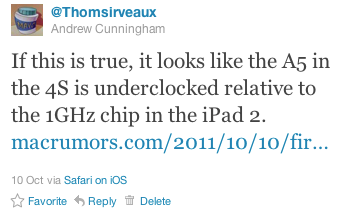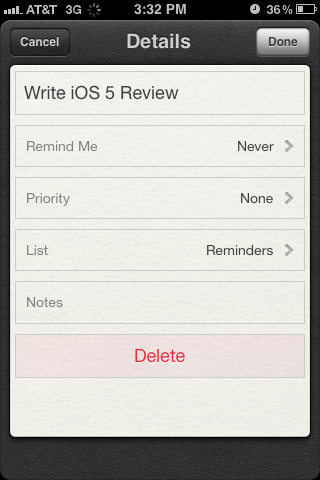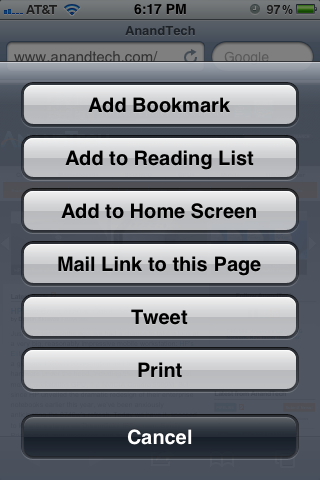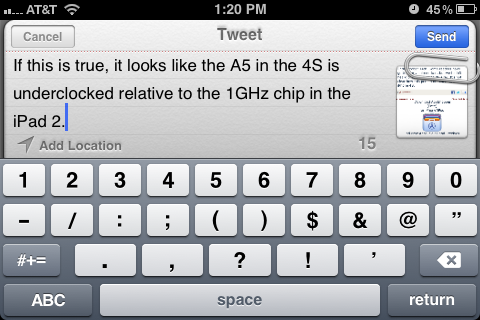Apple iOS 5 Review
by Vivek Gowri, Andrew Cunningham, Saumitra Bhagwat & Brian Klug on October 18, 2011 3:05 AM ESTReminders
Reminders is more or less a portable to-do list. Once you create a reminder, you can edit it, making it remind you on a selected date (after which you can also set up recurring reminders), assigning it a priority, switching the reminder list it appears on, or making notes to associate with it.
You can have multiple lists of Reminders set up, just as you can use multiple calendars or email accounts. By default, you have one list that lives on the device locally (syncing Reminders to iCloud will replace the local one with your iCloud copy), and Exchange tasks can also appear as a Reminders list. In list view, the app will allow you to swipe between your lists of active and completed tasks. You can also use a calendar view for time-sensitive or recurring reminders.
For those of you connecting to Exchange servers, your Reminders will sync with your Tasks lists in Outlook. You should note that, whether you have one Exchange list and one iCloud list, or two iCloud lists, or any other multiple-list configuration, a given Reminder can only live on one list at once.
On certain devices (namely, the iPhone 4 and 4S), you can also set location-based reminders that will trigger an alert when you’ve arrived at a certain geographical location. The accuracy of this feature is contingent on the accuracy of Apple's background location service, which uses cellular based location calls that are limited to the iPhone 3GS or higher. It isn't entirely clear which level of background location method is being used for Reminders, however the "significant-change location service" state outlined under "Tracking the User's Location" is the most likely. This doesn’t work on other WiFi-only devices for an obvious reason - this level of background location service uses individual cell sites to determine rough location. It's curious that the 3GS doesn't get Reminders, but no doubt Apple is reserving this feature for the higher end devices as a selling point.
For those of you connecting to Exchange servers, your Reminders will sync with your Tasks lists in Outlook. You should note that, whether you have one Exchange list and one iCloud list, or two iCloud lists, or any other multiple-list configuration, a given Reminder can only live on one list at once.
On certain devices (namely, the iPhone 4 and 4S), you can also set location-based reminders that will trigger an alert when you’ve arrived at a certain geographical location. The accuracy of this feature is contingent on the accuracy of Apple's background location service, which uses cellular based location calls that are limited to the iPhone 3GS or higher. It isn't entirely clear which level of background location method is being used for Reminders, however the "significant-change location service" state outlined under "Tracking the User's Location" is the most likely. This doesn’t work on other WiFi-only devices for an obvious reason - this level of background location service uses individual cell sites to determine rough location. It's curious that the 3GS doesn't get Reminders, but no doubt Apple is reserving this feature for the higher end devices as a selling point.
We experienced varying levels of accuracy, and again this depends on the density of cell sites in your particular areas. Obviously urban areas are going to have much more granularity, and rural areas might require some significant changes in location to trigger. Apple's guidelines stipulate around 500 meters as being average, which is about right. Some other developers have done their own statistical studies and come up with a good breakdown of how far one must travel for the location-trigger to happen based on this background location level. If you use Google Latitude on iOS, this is (best we can tell) the same background location service used there.
Twitter Integration
You may not really notice this if you don't use Twitter, but for heavy users of the service it's nice to see it integrated more fully into the OS - the ability to share photos and links via Twitter is a first-class menu option, right alongside printing and emailing.
You'll need to have the Twitter app installed to enable this functionality, and you'll also have to save your Twitter authentication credentials in Settings - iOS prompts you to do both if you haven’t. Once you’ve done this, you can select individual apps that can send Tweets using your account (Safari and Photos are here by default, but expect more as developers adopt the APIs).

Custom Vibrations & LED Notification


There are some new accessibility features in iOS 5. You can now create custom vibration patterns as an alert (even on a per-user basis), as well as rely on the LED flash for notifications. The flash isn't quite as nice as a subtle LED notification indicator for normal use but if you need a highly visual alert system, it gets the job done.













86 Comments
View All Comments
Aikouka - Tuesday, October 18, 2011 - link
Have you guys noticed any weird issues with WiFi sync? It seems that whenever I would unplug my phone, iTunes would start freaking out because it couldn't find the phone. That's pretty obvious why... it's no longer on the network since iOS only keeps WiFi alive while plugged in. It would constantly pop up an error about being unable to find my iPhone or iPad.Not to mention leaving "Open iTunes when this device is connected" would cause iTunes to constantly open up... even when closed. Turning this off caused my device to enter some weird limbo state with iTunes. Plugging it in gave me an error, "Another iPhone has sync'd with this computer." The only options were to restore or setup as a new iPhone. A little Googling revealed that the only option was to hit setup as new iPhone and quickly unplug the cable.
It worked, but now my device just comes up as "Apple iPhone" instead of how it used to.
I really don't like iTunes.
kezeka - Thursday, October 20, 2011 - link
I just straight up cannot get it to function with my iPad 2 and MBP. I have tried pretty much everything I can think of without any luck. Not that it bothers me that much, I would just like to have it working to simplify the syncing of the two.name99 - Thursday, October 20, 2011 - link
There are two things you might want to try.(a) Shame on Apple for not making this clear, but you have to go to iTunes and, while the phone is plugged in, toggle the "Sync with this phone over WiFi" checkbox. It is not set by default, and when you try to sync on your phone, the phone gives a useless error message rather than telling you this setting needs to be toggled.
(b) You have to ensure that your phone in on the correct wifi network. If you have a modern Airport base station and have a guest network setup, you must ensure that the phone is NOT on the guest network --- best is to tell the phone to forget the guest network. This makes perfect sense --- the whole point of the guest network is to contact the outside world, without allowing you to contact machines on the local LAN.
StormyParis - Tuesday, October 18, 2011 - link
Guys, I think devoting graphs to gains of 0.1s is... mmmm.... we French say "sodomozing flies". I think the coclusion is 1- don't do graphs for irrelevant sutff (especially, not lots and lots fo thm) 2- a 0.1s improvement is not forth more than a "slightly speedier" comment in passing, and 3- those times are so low to start with, lobel them "very good", and talk about some interesting ?I know benchmarking is fun and all, but we're well past the point of irrelevance.
dingetje - Tuesday, October 18, 2011 - link
hmmm we dutch say f**king Ants.it seems u french are way more pervy than us ;)
cjs150 - Tuesday, October 18, 2011 - link
In depths of northern England we go for sheep - but I think that is a lifestyle choice rather than pithy phrase describing graphs!!Samoht - Tuesday, October 18, 2011 - link
interesting.. in danish it's called flyf**king. Maybe the translation from french to danish didn't carry all the way over ? Or maybe we do not need the specifics;-)Kristian Vättö - Tuesday, October 18, 2011 - link
What they show is that there is no difference, which is kind of their point.grkhetan - Tuesday, October 18, 2011 - link
I didn't know AnandTech did software reviews... I have been coming here every day since the last 3-4 days to see the iPhone 4S review, but finally I see here is an iOS5 review. But even this was high quality as your hardware reviews are -- I love how you go into detail of everything and don't cut back on prose. With hardware your reviews are unmatched in the industry considering your technical depth.Anyway, nice review and great coverage. However, when is the iPhone 4S hardware review coming out?
Blaze-Senpai - Tuesday, October 18, 2011 - link
Go read an iPhone 4 hardware review; it's basically the same thing. The only (physical) changes are minute and you'll get different bar charts.